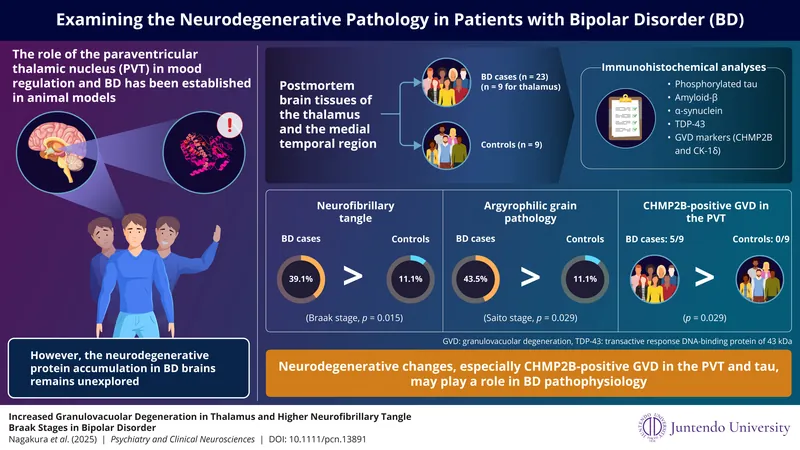
Revolutionary Discovery Links Neurodegenerative Proteins to Bipolar Disorder Symptoms
2025-09-03
Author: Daniel
Unraveling Bipolar Disorder: A Growing Global Challenge
Bipolar disorder (BD) is more than just mood swings; it’s a debilitating mental health condition marked by waves of depression and mania. As its global prevalence climbs, the need to understand its underlying causes grows ever more urgent.
Mitochondrial Dysfunction: A Key to the Mystery
While mitochondrial dysfunction has long been suspected in BD, pinpointing the affected brain regions has remained elusive. Understanding this could unlock new doors in research and therapeutic developments.
Japanese Researchers Take the Helm of BD Exploration
In a groundbreaking initiative, a dedicated team of Japanese researchers, led by Professor Tadafumi Kato and Dr. Akito Nagakura, zeroed in on the thalamus and medial temporal regions—critical zones for mood regulation and cognitive abilities. Their promising findings were unveiled recently in the journal Psychiatry and Clinical Neurosciences.
Delving Deep into Brain Tissues: What Lies Beneath?
With a focus on the paraventricular thalamic nucleus, the researchers conducted meticulous analyses of postmortem brain tissues, assessing neurodegenerative markers like phosphorylated tau, amyloid β, α-synuclein, and TDP-43. Their efforts shed light on the intricate landscape of proteins linked to neurological disorders.
Startling Findings: A Glimpse into the Pathology of BD
The research uncovered alarming evidence of higher neurofibrillary tangle (NFT) stages in BD patients and notable argyrophilic grain pathology, which could indicate an increased tau burden often associated with aging. Significantly, about half of the samples showed a previously unreported accumulation of CHMP2B-positive granulovacuolar degeneration (GVD) in the paraventricular thalamus.
Towards a Deeper Understanding of BD: A Brain-Based Perspective
These compelling discoveries not only strengthen the case for viewing BD as a brain-based ailment but also underline the potential connection between neurodegenerative protein accumulation and dysfunctional brain regions.
A Call for Innovative Treatments and Early Detection
As insights into brain transformations deepen, the need for early identification and personalized treatment strategies becomes crucial. Prof. Kato asserts that their findings could lead to innovative diagnostic tools and targeted therapies that address the very roots of bipolar disorder.
Changing the Future of Bipolar Disorder Research
With this pioneering research, the landscape of bipolar disorder treatment may soon evolve, offering hope to millions affected by this challenging condition. Stay tuned as we uncover the future developments stemming from these groundbreaking insights!


 Brasil (PT)
Brasil (PT)
 Canada (EN)
Canada (EN)
 Chile (ES)
Chile (ES)
 Česko (CS)
Česko (CS)
 대한민국 (KO)
대한민국 (KO)
 España (ES)
España (ES)
 France (FR)
France (FR)
 Hong Kong (EN)
Hong Kong (EN)
 Italia (IT)
Italia (IT)
 日本 (JA)
日本 (JA)
 Magyarország (HU)
Magyarország (HU)
 Norge (NO)
Norge (NO)
 Polska (PL)
Polska (PL)
 Schweiz (DE)
Schweiz (DE)
 Singapore (EN)
Singapore (EN)
 Sverige (SV)
Sverige (SV)
 Suomi (FI)
Suomi (FI)
 Türkiye (TR)
Türkiye (TR)
 الإمارات العربية المتحدة (AR)
الإمارات العربية المتحدة (AR)